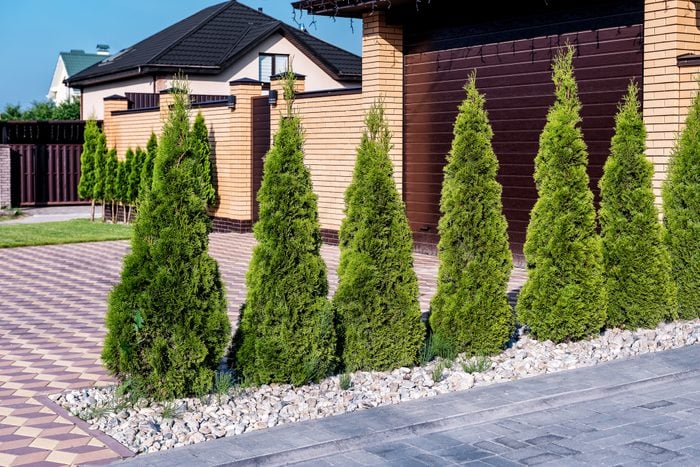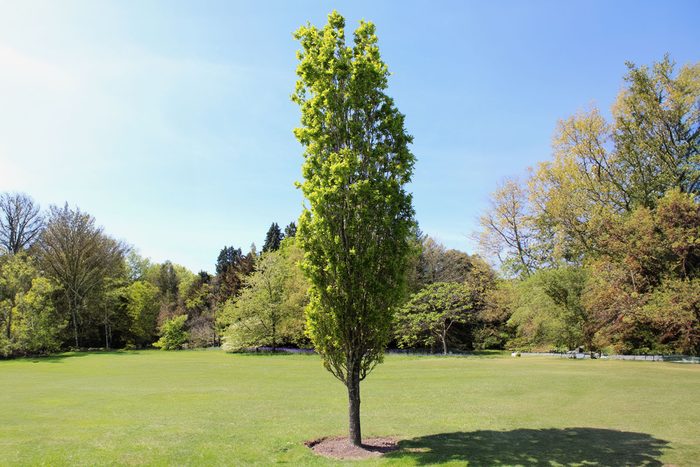
Best Deciduous Landscape Trees for a Privacy Border
That row of Lombardy poplars my dad planted was a great idea … until it wasn’t. He would have chosen a different species if he knew about the canker disease that would eventually kill them. One alternative I like is columnar English oak (Quercus robur ‘Fastigiata’). I planted one at my last house because I love oaks but didn’t have room for a traditional spreading oak. The columnar habit features upright branching, which minimizes the need for horizontal growing space. And the faded brown foliage remains on the tree over winter to contrast nicely with snow.
Andy Schmitz, horticulture director at the Brenton Arboretum in central Iowa, also likes the tree. “It grows fast in good soils,” Schmitz says. “I planted one in my front yard back in 2007 and it was less than 8 ft. tall. Last year, it was 55 ft. tall.” Meanwhile, spread at maturity is just 10 to 15 ft. English oak is hardy in USDA Zones 5-8.
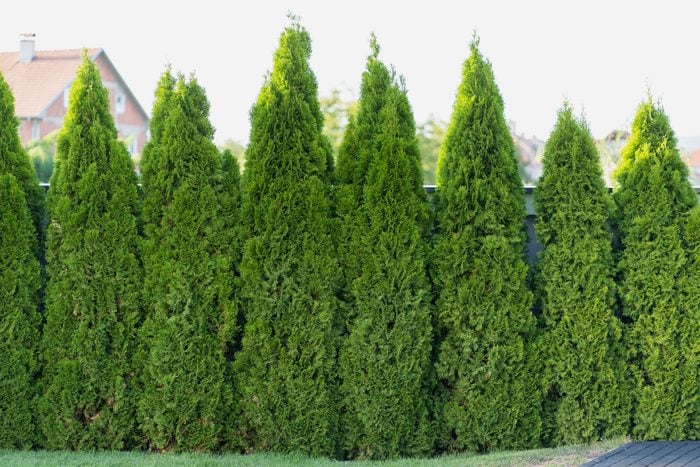
Best Evergreen Landscape Trees for a Privacy Border
An evergreen Schmitz recommends is Eastern red cedar (Juniperus virginiana ‘Taylor’). “We have three of them at the arboretum, and when people ask me, ‘How much maintenance do they require?’ I say, ‘I haven’t been within 50 ft. of those trees in 10 years.’” While the species can grow 30 to 65 ft. tall and up to 25 ft. wide, ‘Taylor’ is more compact, with a height of 20 to 25 ft. and spread of just 3 to 4 ft.
Eastern red cedar has a dense, conical shape offering plenty of year-round privacy. It is adaptable to cold weather, hot weather, various soils and even drought — plus, it has a range from Maine to northern Florida and west to the Plains. ‘Taylor’ is hardy in USDA Zones 3-9.
Pete Smith, a certified forester and arborist who supports community forestry and education programs at the Arbor Day Foundation, also likes Eastern red cedar. He adds these other suggestions for the south:
• Arborvitae (Thuja occidentalis): “Its columnar shape and dense foliage makes this species, and many cultivars, the top choice for tall screening plants,” Smith says. It can reach 40 to 60 ft. tall and 10 to 15 ft. wide, but there are many cultivars maturing at under 10 ft. It is hardy in USDA Zones 3-7.
• Live oak (Quercus virginiana): “Give the live oak a bit more space and you have a long-lived screen that’s well suited to the Southern climate and habit,” Smith says. It usually matures at 40 to 80 ft. tall, 30 to 100 ft. wide. Live oak is hardy in USDA Zones 8-10.
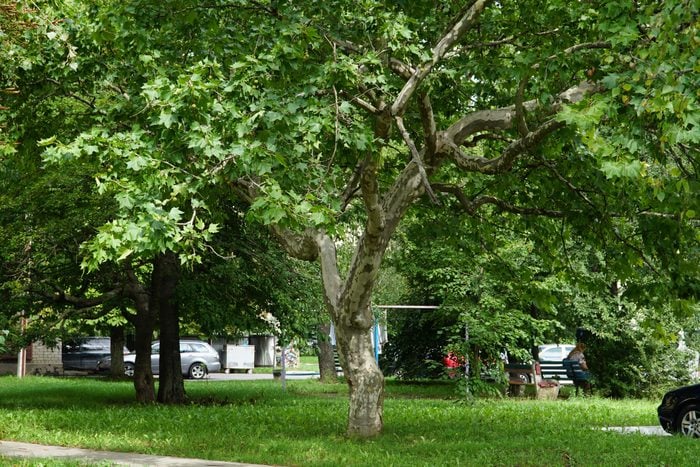
Best Large Landscape Trees for Quick Shade
Oaks and maples are popular shade trees, and I’m a big fan of both. But there’s an underutilized alternative worth considering: American sycamore (Platanus occidentalis). “It grows fast, is long-lived, great for shade, and has really good branching structure and thus requires very minimal pruning,” says Schmitz. He chooses the native species over its European relative, the London planetree, which has issues with cold hardiness and tip dieback. “I really don’t see a reason to plant it over our native tree.”
American sycamore has unique patchy “camouflage” bark that reveals large swatches of whitish bark as it matures. American sycamore can grow quite large — 75 to 100 ft. tall and 40 to 70 ft. wide — so choose a planting site carefully. It is hardy in USDA Zones 4-9.
Smith included American sycamore with his recommendations, alongside:
• Tulip-poplar (Liriodendron tulipifera): a large, fast-growing, tall shade tree that prefers moist, well-drained sites. Its leaves are shaped like the silhouette of tulips, while the yellow and orange flowers look like open tulips. Tulip-poplar can grow 60 to 90 ft. tall and 30 to 50 ft. wide. It is hardy in USDA Zones 4-9. Note: dropped flowers can be slippery, so avoid planting these trees near walkways, driveways, patios and decks.
• American sweetgum (Liquidambar styraciflua): “It has the best fall color of any southern native tree,” Smith says. “It grows straight, with a pyramidal shape when young.” The bristly star-shaped gumballs remain on the tree for winter interest but can create cleanup problems for patios and driveways, so avoid those areas when planting. It grows 60 to 80 ft. tall, 40 to 60 ft. wide and is hardy in USDA Zones 5-9.
• Pecan (Carya illinoinensis): One of the quicker-growing hickories, it can reach a mature size of 75 to 100 ft. tall and 40 to 70 ft. wide. Pecan makes a good shade tree and has the added benefit of dropping tasty nuts in the fall. It is hardy in USDA Zones 5-9.
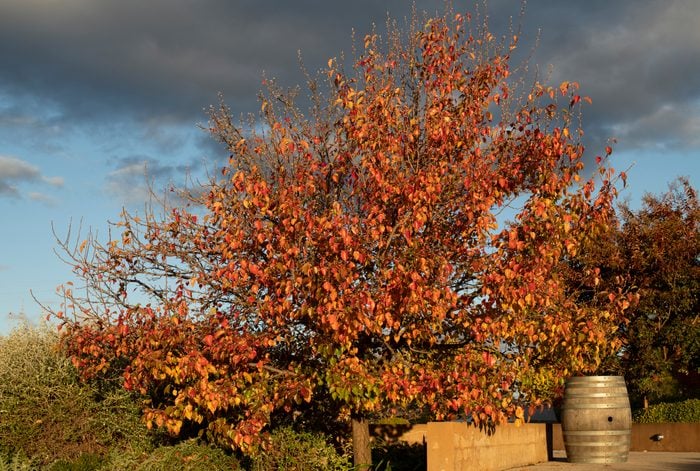
Best Medium-Size Landscape Trees for Quick Shade
Not everyone has room for a gigantic shade tree, so you might want to consider an alternative with more modest proportions. I like Blackgum (Nyssa sylvatica), also called Tupelo. According to the Iowa Department of Natural Resources, it’s a good alternative to the overplanted Red maple (Acer rubrum).
I don’t disagree, and after one look at the striking scarlet red fall foliage, you wouldn’t either! Tupelo is a little slower growing than the ubiquitous red maple, but the wait is worthwhile. Tupelo grows 30 to 50 ft. tall and 20 to 30 ft. wide. It is hardy in USDA Zones 4-9.
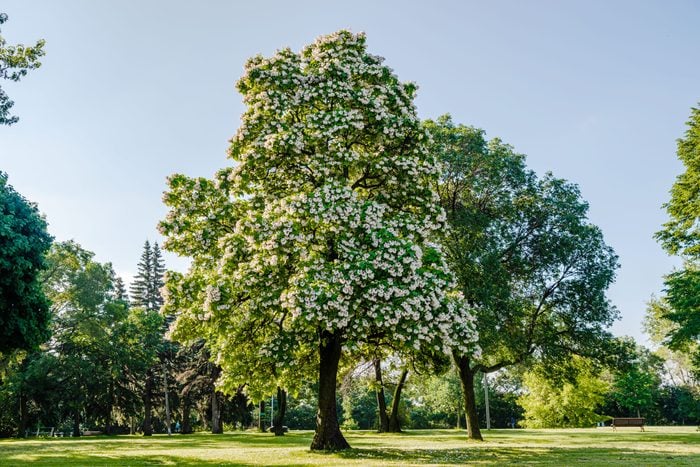
Best Large Landscape Trees for Multiseason Interest
For multiseason interest in a large tree, consider the Northern catalpa (Catalpa speciosa). It is seriously fast-growing and has huge heart-shaped leaves and delightful white flowers with yellow and purple markings to keep pollinators happy. “Driving down I-235 in Des Moines, when catalpas are all in bloom in early summer, there is nothing really else blooming — and definitely not a 60-ft.-tall tree loaded with white flowers,” Schmitz says.
The bright green leaves turn yellow in fall, but it is the long, cylindrical seedpods that give the tree its nickname “cigar tree.” They turn brown and hang from the tree all winter, looking like long, slender cigars. Northern catalpa grows 40 to 60 ft. tall and 20 to 40 ft. wide. It is hardy in USDA Zones 4-8. The related Southern catalpa (Catalpa bignoniodes) overlaps the range of Northern catalpa but also grows further south. It grows 30 to 60 ft. tall, 20 to 40 ft. wide and is hardy in USDA Zones 5-9.
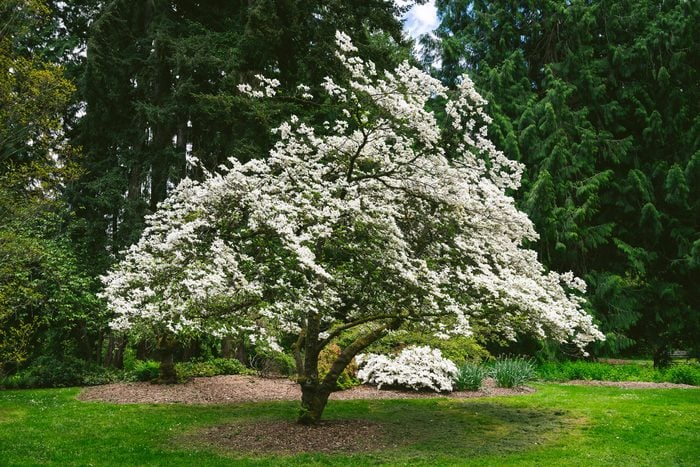
Best Small Landscape Trees for Multiseason Interest
On the smaller side, a good candidate for multiseason interest is serviceberry. There are a number of quality species, but one that Brenton’s Andy Schmitz really likes is Apple serviceberry (Amelanchier x grandiflora ‘Autumn Brilliance’). It has white flowers in spring before the foliage appears, followed by colorful fruit beloved by wildlife. The blue-green leaves persist through summer, turning red in fall. And the multi-stem habit and silvery gray bark are best enjoyed in winter. “It’s a great wildlife tree, feeding birds and mammals,” Schmitz says.
One reason he picks it over other serviceberries: “It can be trained as a 3- to 5-stemmed small tree, whereas most of our serviceberries are more multistemmed suckering shrubs. Plus, it has consistent fall color.” Apple serviceberry grows 15 to 25 ft. tall and 20 to 25 ft. wide. It is hardy in USDA Zones 4-9.
Serviceberries also work in the south, but here are two other recommendations from the Arbor Day’s Pete Smith:
• Flowering dogwood (Cornus florida): “From its white flowers in early spring, to the deep reds and purples of fall foliage, each season brings a new treat for the eyes!” Smith says.
• Crapemyrtle (Lagerstroemia indica): “A staple of the South, this small, muscular, multi-trunk tree blooms in crape-like flowers of many colors in the hottest part of summer,” he says.
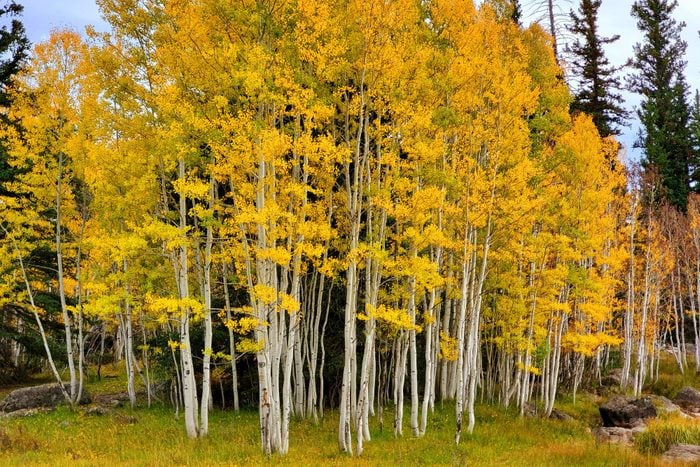
Best Landscape Trees for a Naturalistic Grove
My first instinct is to recommend Quaking aspen (Populus tremuloides). Aspens naturally grow in groves (each stem attached to the same root structure) and look splendid in that role thanks to the creamy white bark and golden yellow fall foliage.
If space is a consideration, there is a columnar Swedish aspen cultivar available. I bought six on closeout last summer and they look great planted together. I can’t wait till they mature. Quaking aspen grows 40 to 50 ft. tall and 20 to 30 ft. wide (10 ft. wide for columnar Swedish cultivar). It is hardy in USDA Zones 2-7.
For a naturalistic grove that can go further south, try Eastern redbud (Cercis canadensis). Both Schmitz and a colleague of mine who works for a tree nursery gave the same recommendation. “A group of these in flower — what a sight in early spring,” Schmitz says. “Redbuds have an early season flower display before they leaf out in spring, orangish-reddish bark and ornamental seed pods that hang on through the winter.”
Most redbuds have pink flowers — others have white. Intriguing new cultivars are coming through the pipeline, including Pink Pom Poms, with double pink flowers but no seedpods to litter the ground. Redbud grows 20 to 30 ft. tall and 25 to 35 ft. wide. It is hardy in USDA Zones 4-9.
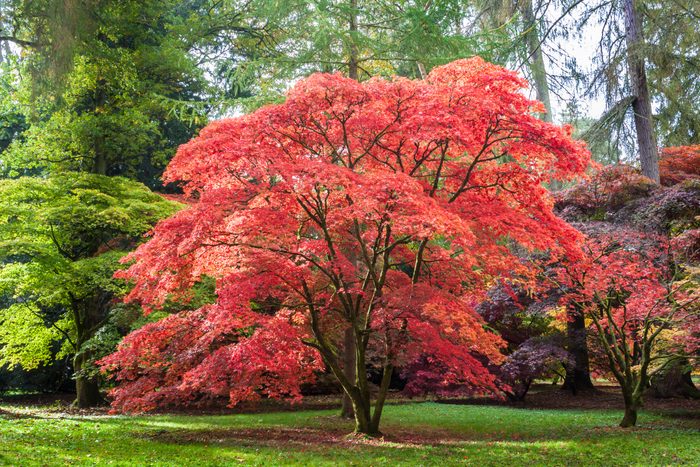
Best Landscape Trees for Front Entryway Stardom
I’ve always liked Japanese maple (Acer palmatum) for this job and planted a small waterfall variety near my front entryway last fall. It’s only a foot tall and will mature at under 4-ft. tall and wide, so it won’t overpower the space. The green leaves should turn a nice orange-red in fall.
But here’s the thing with Japanese maples: there are oodles of them in all sorts of sizes and habits. Some have dissected leaves, others palm-shaped. You can get them in green or burgundy. And even those cultivars that mature at 25 ft. grow slowly enough that you can easily train them. Some people plant them directly in line with the front door, removing lower branches and foliage to allow you to see through the tree.
Japanese maples are hardy in Zones 6-8, with some cultivars (like mine) hardy to Zone 5. They also work in the south, as do these recommendations from Smith:
• Yaupon (Ilex vomitoria), a small evergreen with red berry-like fruits throughout winter. It matures at 10 to 20 ft. tall and 8 to 12 ft. wide and is hardy in USDA Zones 7-9.
• Saucer magnolia (Magnolia x soulangeana) has showy spring blossoms of lavender followed by light green foliage that turns yellow in fall. It grows about 20 to 30 ft. tall and wide and is hardy in USDA Zones 4-9.
• Mexican plum (Prunus mexicana) is an early spring flowering native with dark bark and edible fall fruits. It grows 15 to 25 ft. tall and wide and is hardy in USDA Zones 6-8.
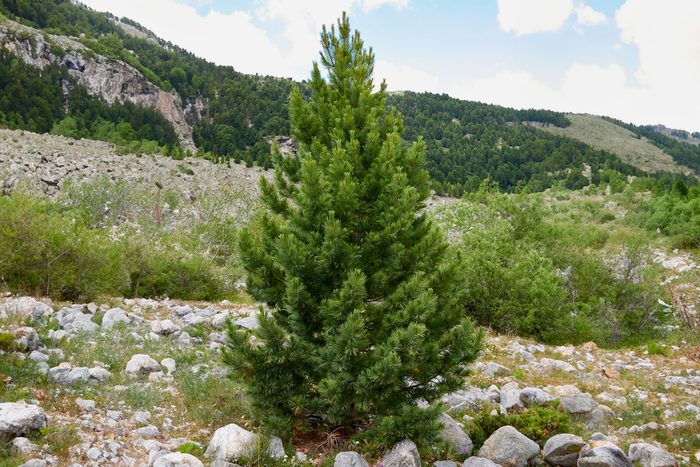
Best Landscape Trees for Outdoor Decorating
That white spruce of my boyhood home quickly outgrew our ability to hang Christmas lights on it without a ladder. That is not a problem with Swiss stone pine (Pinus cembra). “It grows slow but will always stay smaller,” says Schmitz. “I have white pines 20 times as large as our Swiss stone pines, and both species were planted the same year.”
Swiss stone pine offers a narrow, pyramidal habit along with dense, full foliage that typically retains its dark green color throughout the winter. “And since it doesn’t get huge so fast, it would be a tree you decorate for many years — but standing on the ground with no ladder — and it’s in proportion to people viewing it as decorated Christmas tree,” Schmitz says. Swiss stone pine matures at 30 to 40 ft. tall and 15 to 25 ft. wide. It is hardy in USDA Zones 3-7.
Further south, Smith likes Baldcypress (Taxodium distichum) where space permits. A deciduous conifer that can grow in swamps or normal soil, it looks like an evergreen during the growing season but eventually turns to a rust color in fall and drops its needles. Baldcypress grows 50 to 70 ft. tall, 20 to 30 ft. wide and is hardy in USDA Zones 4-9.
For hotter, drier conditions, he suggests Arizona cypress (Cupressus arizonica). “Another pyramidal evergreen, this western native can be used on hot, dry locations and still make a good frame for holiday lights in the winter,” Smith says. It’s fast-growing and drought-tolerant. Arizona cypress grows 20 to 50 ft. tall, 16 to 20 ft. wide, and is hardy in USDA Zones 7-11.
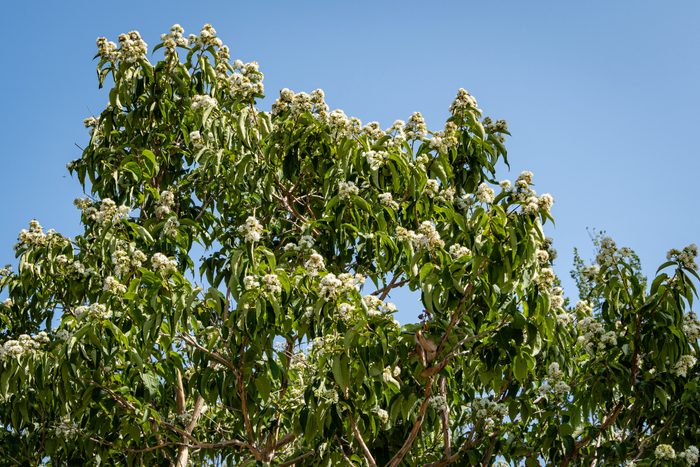
Best Landscape Trees for Pollinators
Here’s another tree Brenton’s Andy Schmitz and I both listed at the top of our choices for the category: Seven-son flower tree (Heptacodium miconiodes). I grew it at my last two houses — that’s how much I like it. The tree’s habit and peeling bark give it character, but it’s the late-summer blooms that really catch the eye. They’re white in September, then the sepals turn rosy red the following month.
“This thing is a magnet for pollinators, bees, bumblebees, moths and butterflies,” Schmitz says, adding that the late bloom period is beneficial for Monarch butterflies heading south. “I have one in my backyard that, when it’s in flower, is covered with bees and butterflies all day and moths and other insects all night. I had at least 24 monarchs on it last fall.”
The seven-son flower tree is a multi-stem tree or large shrub maturing at 15 to 20 ft. tall and 8 to 10 ft. wide, although the Temple of Bloom cultivar is just 6 to 10 ft. tall and wide. It is hardy in USDA Zones 5-9.
Smith adds a whole genus of trees to the recommendations: Oaks (Quercus spp.). “These trees are host plants for up to 300 different species of insect larvae,” he says. “If you want to benefit pollinators, plant an oak tree!” He adds that flowering trees only help insects for a short time, but leaves of native trees are crucial to the lifecycle of many pollinators.
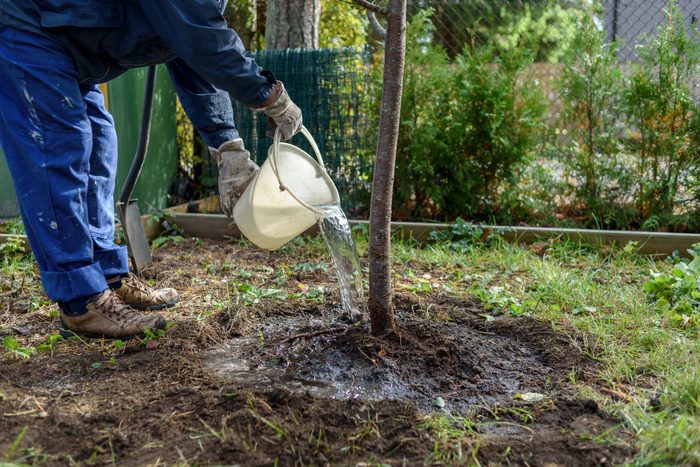
For More Information
The choice of tree species is highly dependent on geographic factors. To understand what trees will thrive in your region, check out the Arbor Day Foundation’s Tree Wizard feature on arborday.org. It will help you identify your Hardiness Zone and understand local soil conditions and sunlight availability.
Once you have that information, you can narrow your search by tree variety, mature height and other preferences and select the perfect tree for planting in your outdoor space.
About the Experts
Andy Schmitz has spent the past 25 years as Horticulturist at the Brenton Arboretum in Dallas Center, Iowa, where he grows, plants and cares for trees while observing their performance. He holds a Bachelor’s Degree in Horticulture from Iowa State University and an Associate’s Degree in Horticulture from Hawkeye Community College.
Pete Smith is a Certified Forester and a Certified Arborist, supporting community forestry and education programs at the Arbor Day Foundation. Before joining the Foundation in 2014, Pete spent 26 years with the Texas A&M Forest Service, completing his tenure as state coordinator for the Urban & Community Forestry program.
